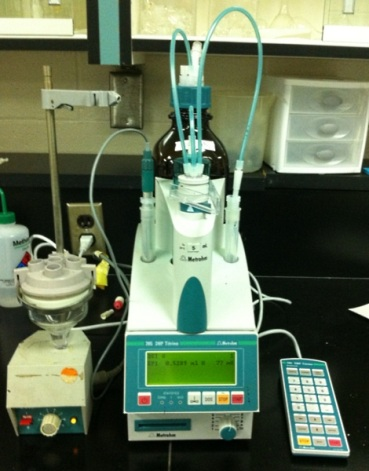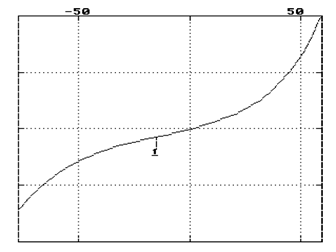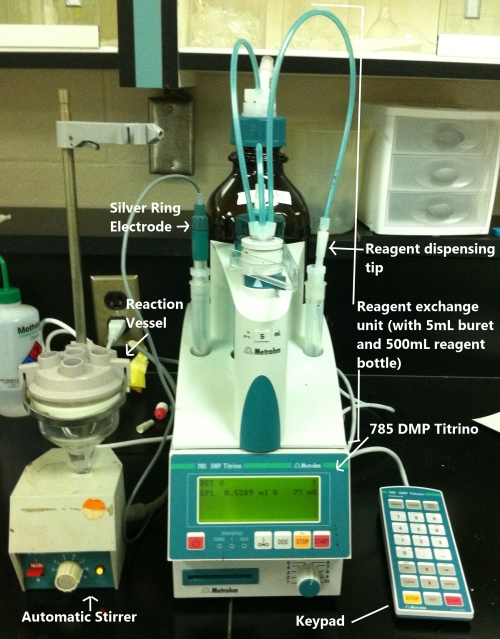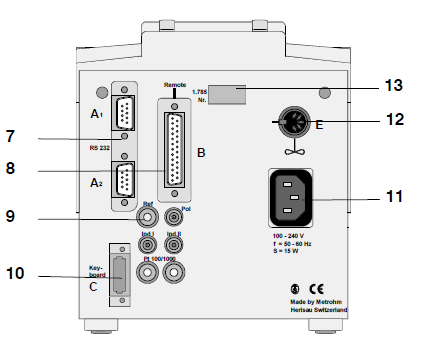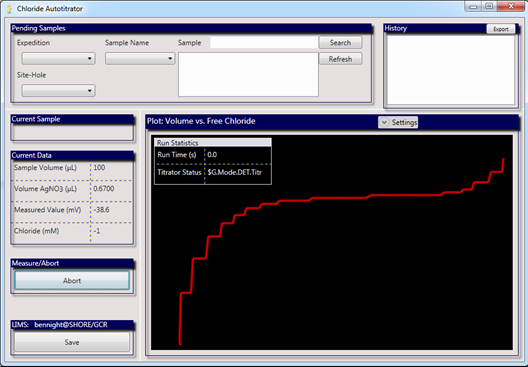| Table of Contents | ||
|---|---|---|
|
Chloride by Autotitrator: User Guide (from CI_Autotitrator_UG_371T_draft_
V1.1 (C. Bennight 10/2/2011; Approved by DJH 10/23/2013)
V371T (D. Houpt, July 2017)
Introduction
This manual describes the operational methods, standard maintenance, and systems integration of the Metrohm 785 DMP Chloride Autotitration System (Figure 1). Methods describes in this manual are based on the Metrohm manual, Metrohm Application Bulletin 130/2 e (Chloride titrations with potentiometric indication), and email correspondence with Gretchen A. Robertson at the Scripps Institution of Oceanography.
This manual covers the USIO standard method for the determination of chloride via potentiometric titration, Variation A – with Nitric Acid.
Figure 1. Chloride Autotitration System.
Theory of Operation
The Cl autotitrator uses a potentiometric endpoint to determine the amount of free (unbound) chloride in a solution. A silver nitrate reagent is aliquotted into an unknown solution with some amount of dissolved chloride in solution. As the silver nitrate is added the following reaction occurs.
Ag+(aq) + Cl–(aq) ® AgCl(s)
The product, AgCl, is insoluble in water and precipitates. A silver-specific electrode in the solution measures a value proportional to the amount of free silver in solution.
As the silver chloride reagent is added, a measurement (in mV) is taken from the silver-specific electrode. If we consider the function of volume added versus the electrode reading and find the volume where the second derivative of the function is 0 (or the inflection point), we have found our equivalence point (Figure 2).
Figure 2. Potentiometric Equivalence Point.
For most purposes, this first equivalence point corresponds to the volume where all free chloride has been converted to AgCl. Knowing the volume of reagent added, the concentration of reagent, and the stoichiometric ratio between reagent and chloride (1:1), we can determine the amount of chloride contained in the solution:
[Cl–] = ([AgCl] × Volume(AgNO3))/Volume(Sample)
(Note: A value in brackets ([]) indicates the concentration of the item enclosed in brackets.)
Volume(AgNO3) is simply the volume of reagent added when the first equivalence point is reached.
Assumptions
It is assumed that the first equivalence point corresponds to that of the AgCl reaction. Silver forms sparingly soluble precipitates with other anions as well as chloride. Solutions with high concentrations of bromide or iodide may cause an erroneous first equivalence point (as they titrate before chloride). In these cases, the method on the instrument will need to be adjusted to run past the first endpoint and to determine the Volume(AgNO3) value. The reagent volumes for the non-chloride endpoints must be subtracted from the reagent volume for the chloride endpoint. It should be fairly obvious which the chloride endpoint is, and chloride will typically be many times more concentrated in situ than other anions.
Apparatus, Reagents, and Materials
Hardware
785 DMP Titrino
The 785 DMP is the primary piece of the instrument. All other components connect to it and it provides the logic and outputs to run the titration (Figure 3).
Figure 3. Titrino Autotitrator.
Reagent Exchange Unit
This interchangeable unit contains the following:
–500 ml reagent bottle
–Exchange burette (5 ml)
–Reagent tubing
–Reagent dispensing tip
Titrino Keypad
This auxiliary data entry device can be used to control the Titrino manually. It is not needed for any of the methods described in this manual.
Silver Electrode
Specifically, a Metrohm 6.0430.100, their "Ag Titrode," this electrode combines a standard silver ring electrode with a pH membrane to serve as the reference. It is the only electrode required for this method. It measures the concentration of silver ions in solution. The metal ring on the tip of the silver titrode may be periodically cleaned by scrubbing gently with toothpaste. Cleaning in this manner will reduce the titrode efficacy over time. The titrode should be stored in DI water long term. Trichloroethylene may be used to degrease the probe. See Storage of Metal Electrodes for more info.
Automatic Stirrer
This electronic stirrer is controlled by the 785 DMP Titrino. Note that the stir bar will not activate until the titration has started.
Reaction Vessel
This is a non-water-cooled narrow bottom reaction vessel. The electrode and reagent dispensing tip are inserted down into the narrow portion of the vessel to reduce the volume required for the overall reaction.
Reagents
Dilution Solution
- Add about 500 mL of 18 MΩ deionized (DI) water to a 1L volumetric flask. Pipette in 6.08 mL of concentrated trace-metal grade nitric acid. Make up to 1 L with 18 MΩ deionized (DI) water (reagent water). Note: Always add acid to water.
Note: Make this solution fresh for each run (typically keep no longer than 1 day). Adjust proportions of solution to make the desired final volume.
0.015 M silver nitrate solution
Dilute 150 ml of 0.1 M silver nitrate stock solution with 1 l reagent water, or dissolve 2.548 g silver nitrate in 1 l reagent water.
General Equipment Setup and Operation
Setting Up The Instrument
To install the instrument for the first time:
1. | Remove the 785 DMP unit from the container, locate the following cords, and plug them into the indicated slot (Figure 4): |
2. | Connect the other end of the serial cable to the back of the computer host that will control this device. |
3. | Power on the instrument by pressing the power button on the front panel of the 785 DMP unit. |
4. | Flip the power switch up on the front of the electronic stirrer (stirring will not start until the run actually begins – controlled by the 785DMP unit). |
Figure 4. 785DMP Connector Slots.
Operation
The settings for the titrator can be accessed by connecting the titrino's detachable keypad to the instrument. The titrator should be set with the following settings using the keypad.
- Mode
- Set mode to DET
- Config
- COM1 and COM2
- set Handshake to none
- Peripheral Controls
- set Stirrer Control to on
- COM1 and COM2
- Parameters
- Titration Parameters
- set Meas. Pt. Density to 0
- set Signal Drift to 10
- Stop Condition
- set Stop EP to 1
- Titration Parameters
Purging the lines
The lines connecting the reagent bottle to the reagent dispensing tip must be purged before analysis can begin. Wear gloves and safety glasses for this operation.
1. | Place the acid dispensing tip in a Ziploc bag—but make sure it's not completely air tight. |
2. | Tap, clamp, or have an individual hold the bag and tip up so it is the highest portion of the system. |
3. | Turn the dispensing speed knob in the bottom right of the device fully clockwise to its maximum setting (if it isn't there already). |
4. | Press and hold the DOS button on the front of the 785 Titrino. While the unit is dispensing flick the reagent lines with your fingers to dislodge any stuck air bubbles. |
5. | When the burette has exhausted its capacity (5 ml), press the FILL button on the front of the 785 Titrino. This will cause the burette to aspirate reagent from the bottle. While this is occurring, flick the exchange lines between the burette and the reagent bottle to dislodge air bubbles. |
6. | Repeat steps 4 and 5 until no air bubbles are visible in any of the exchange lines. |
Shutting down the instrument
1. | Rinse the dispensing tip in DI water and store in DI water (add a small amount to the housing in the exchange unit where the tip sits). |
2. | Rinse the electrode in a 3 M sodium nitrate solution or 2 M nitric acid solution followed by DI water. |
3. | Store the electrode in DI water (add to the housing in the exchange unit where the electrode sits). |
Calibration
It is recommended to ‘re-calibrate’ the system whenever the silver nitrate solution is replaced, if the electrode needs replacing, if you replace the dilution solution and your checks are not acceptable or during normal operation when once again your checks are not within acceptable limits.
| 1. | Click on the SETTINGS button in the software window. Change the eluent molarity parameter to 0.015 (or whatever your concentration is thought to be). |
| 2. | Measure IAPSO five times and average the measurements. |
| 3. | Update the eluent molarity field using:
Note: 0.015 is the original AgNO3 concentration in this example. In practice, use the value listed in the "Eluent Molarity" field of the "Settings" dropdown menu when the five IAPSO measurements were performed. The concentrations of those measurements are proportional to the molarity the user initially input into the software. |
| 4. | Re-measure IAPSO. The values should be close to 559. |
NOTE: when changing the AgNO3 solution, make sure that you flush all lines, with the new solution, before attempting to re-calibrate.
Analyzing Samples
1. | Place stir bar in bottom of reaction vessel. |
2. | Pipette 100 µl of sample into the bottom of the reaction vessel. |
3. | Pipette 30 ml of dilution solution into the bottom of the reaction vessel (the actual amount isn't important as long as the electrode is submerged). |
4. | Insert the electrode and reagent dispensing tip into the reaction vessel. |
5. | Start the software – ClAutotitrator. |
6. | Log in using LIMS username/password. |
7. | Select the sample to be measured by filling in Expedition, Site-Hole, Sample Name, and Sample (Figure 5). |
8. | Click the measure button (Figure 6). |
9. | While the instrument is running, the plot displays the current data set as well as instantaneous values for volume of reagent added, current value, run time, and current titrator status. No interaction is required. |
10. | When the run is complete a sound will play and a window will pop up telling you that the run is finished (Figure 7). Click Save to upload the data to LIMS. |
Figure 5. Enter Sample Information.
Figure 6. Measure Sample.
Figure 7. Run Complete.
QAQC
IAPSO is used a standard for this analysis. The certified value, typically ~559 mM, is printed on the outside of each bottle. For quality control purposes, IAPSO shall be run as a sample as follows:
–Before every run
–As the last sample of any run
–Every 5 samples or 2 hours, whichever comes first.
Data Available in LORE
Interstitial Waters Standard Report
- Exp: expedition number
- Site: site number
- Hole: hole number
- Core: core number
- Type: type indicates the coring tool used to recover the core (typical types are F, H, R, X).
- Sect: section number
- A/W: archive (A) or working (W) section half.
- Top offset on section (cm): position of the upper edge of the sample, measured relative to the top of the section.
- Bottom offset on section (cm): position of the lower edge of the sample, measured relative to the top of the section.
- Top depth CSF-A (m): position of observation expressed relative to the top of the hole.
- Top depth [other] (m): position of observation expressed relative to the top of the hole. The location is presented in a scale selected by the science party or the report user.
- Sampling tool: tool used to collect sample
- Data columns: header lists parameter measured and concentration units, followed by wavelength (for ICP-AES) and then analysis method.
Expanded TITRA_MAN Report
- Exp: expedition number
- Site: site number
- Hole: hole number
- Core: core number
- Type: type indicates the coring tool used to recover the core (typical types are F, H, R, X).
- Sect: section number
- A/W: archive (A) or working (W) section half.
- text_id: full text ID of sample
- sample_number: sample number of sample. text ID with sample type prefix removed.
- label_id: id combining exp, site, hole, core, type, sect, A/W, parent sample name (if any), sample name
- sample_name: name of sample
- x_sample_state:
- x_project: expedition project the sample is uploaded under. typically the same as Exp.
- x_capt_loc:
- location: location sample was taken
- x_sampling_tool: tool used to collect sample
- changed_by: name of person who uploaded sample
- changed_on: date and time sample was uploaded
- sample_type: type of sample. typically LIQ, for liquid.
- x_offset: top offset of parent sample where sample was taken in m
- x_offset_cm: top offset of parent sample where sample was taken in cm
- x_bottom_offset_cm: bottom offset of parent sample where sample was taken in cm
- x_diameter:
- x_idmp:
- x_orig_len:
- x_length: length of sample in m
- x_lengeth_cm: length of sample in cm
- status:
- old_status:
- original_sample:
- parent_sample:
- standard:
- login_by: name of person logged into LIMS application used for this test
- sampled_date:
- legacy:
- test changed_on: date of last edit of analysis
- test date_started: date analysis was started
- test group_name:
- test status:
- test old_status:
- test test_number: number assigned to performed analysis on sample
- test date_received: date analysis was uploaded to LIMS
- test instrument: instrument used to perform analysis
- test analysis: analysis type
- test x_project: project test was assigned to
- test version:
- test order_number:
- test replicate_test:
- test replicate_count:
- rest sample_number: sample number for sample the analysis was performed on
Top depth CSF-A (m): position of observation expressed relative to the top of the hole.
Bottom depth CSF-A (m): position of observation expressed relative to the top of the hole.
Top depth CSF-B (m):
Bottom depth CSF-B (m):
- ammonium (mM): concentration of ammonium
- calcium (mM): concentration of calcium
- chloride (mM): concentration of chloride in mM
- dilution_factor: the amount the sample was diluted by
- magnesium (mM): concentration of magnesium
- phosphate (uM): concentration of phosphate
- ssup_asman_id:
- ssup_filename:
- sulfide (uM): concentration of sulfide
- titrant_amount (mL):
sample description: description/comment of sample
test test_comment: comment added for performed analysis
result comments: comment added for analysis results
Software
There is one piece of software associated with this instrument, the in-house: Cl Autotitrator piece. It is a WPF application written in C# against the 4.0 .NET runtime. The following table describes its characteristics.
Characteristic | Description |
Supported Operating Systems | Windows 7 – 64 bit |
Source Code | |
Deployment | The project is deployed as a Click Once application installable without administrative permissions. The install page is at: http://web.ship.iodp.tamu.edu/tasapps/cltitrator/ |
Web Services | This project makes calls to the Web Services (WAPPS). Specifically, it:
|
Health, Safety, and Environment
The primary safety concerns for this instrument and method relate to chemical handling and disposal.
Nitric Acid
2.2 M nitric acid is required by this method; if it is made in house then, handling of concentrated nitric acid is required. Nitric acid is an oxidizer and should not be brought into contact with any organic materials.
Nitric Acid, Concentrated
–Open and handle concentrated nitric acid in a working fume hood.
–When diluting, always add acid to water.
–Wear gloves and safety glasses at all times when handling concentrated nitric acid.
–Body contact: rinse immediately with copious amounts of water.
–Clothing contact: remove the clothing and rinse with water and/or acid neutralization solution.
–If a spill occurs apply an acid neutralization solution to the spill area.
Nitric Acid, Dilute (2.2 M)
–Store this solution in the non-organic acid section of a ventilated fume hood storage cabinet.
–This acid can be aliquotted outside of a fume hood.
–Always wear gloves worn when using this solution.
–Neutralize or flush with copious amounts of water for disposal of this solution or waste products.
–Follow the recommendations for the concentrated solution above if contact with skin or clothing.
Silver Nitrate Solution (0.10 M)
The primary hazard from silver nitrate solution is contact with body parts. It forms a silver compound and turns black, staining the skin and other membranes until they are naturally replaced by the body (typically 1–3 weeks). Certain individuals may also exhibit redness, swelling, and rash-like symptoms in the afflicted area. Of particular concern is getting the solution in the eye. Care should be taken to avoid this.
–Use gloves and eye protection when transferring the stock solution to the reagent bottle.
–Use gloves when handling the waste solution—it contains a small amount of unreacted silver.
LIMS Component Table
Although the titrator could theoretically be used to titrate a number of constituents (e.g., Ca2+, S2-), it is in practice only used for chlorinity. Nonetheless, the LIMS component table includes those other analytes should they ever be done by titration.
| ANALYSIS | TABLE | NAME | ABOUT TEXT |
| TITRA_MAN | SAMPLE | Exp | Exp: expedition number |
| TITRA_MAN | SAMPLE | Site | Site: site number |
| TITRA_MAN | SAMPLE | Hole | Hole: hole number |
| TITRA_MAN | SAMPLE | Core | Core: core number |
| TITRA_MAN | SAMPLE | Type | Type: type indicates the coring tool used to recover the core (typical types are F, H, R, X). |
| TITRA_MAN | SAMPLE | Sect | Sect: section number |
| TITRA_MAN | SAMPLE | A/W | A/W: archive (A) or working (W) section half. |
| TITRA_MAN | SAMPLE | text_id | Text_ID: automatically generated database identifier for a sample, also carried on the printed labels. This identifier is guaranteed to be unique across all samples. |
| TITRA_MAN | SAMPLE | sample_number | Sample Number: automatically generated database identifier for a sample. This is the primary key of the SAMPLE table. |
| TITRA_MAN | SAMPLE | label_id | Label identifier: automatically generated, human readable name for a sample that is printed on labels. This name is not guaranteed unique across all samples. |
| TITRA_MAN | SAMPLE | sample_name | Sample name: short name that may be specified for a sample. You can use an advanced filter to narrow your search by this parameter. |
| TITRA_MAN | SAMPLE | x_sample_state | Sample state: Single-character identifier always set to "W" for samples; standards can vary. |
| TITRA_MAN | SAMPLE | x_project | Project: similar in scope to the expedition number, the difference being that the project is the current cruise, whereas expedition could refer to material/results obtained on previous cruises |
| TITRA_MAN | SAMPLE | x_capt_loc | Captured location: "captured location," this field is usually null and is unnecessary because any sample captured on the JR has a sample_number ending in 1, and GCR ending in 2 |
| TITRA_MAN | SAMPLE | location | Location: location that sample was taken; this field is usually null and is unnecessary because any sample captured on the JR has a sample_number ending in 1, and GCR ending in 2 |
| TITRA_MAN | SAMPLE | x_sampling_tool | Sampling tool: sampling tool used to take the sample (e.g., syringe, spatula) |
| TITRA_MAN | SAMPLE | changed_by | Changed by: username of account used to make a change to a sample record |
| TITRA_MAN | SAMPLE | changed_on | Changed on: date/time stamp for change made to a sample record |
| TITRA_MAN | SAMPLE | sample_type | Sample type: type of sample from a predefined list (e.g., HOLE, CORE, LIQ) |
| TITRA_MAN | SAMPLE | x_offset | Offset (m): top offset of sample from top of parent sample, expressed in meters. |
| TITRA_MAN | SAMPLE | x_offset_cm | Offset (cm): top offset of sample from top of parent sample, expressed in centimeters. This is a calculated field (offset, converted to cm) |
| TITRA_MAN | SAMPLE | x_bottom_offset_cm | Bottom offset (cm): bottom offset of sample from top of parent sample, expressed in centimeters. This is a calculated field (offset + length, converted to cm) |
| TITRA_MAN | SAMPLE | x_diameter | Diameter (cm): diameter of sample, usually applied only to CORE, SECT, SHLF, and WRND samples; however this field is null on both Exp. 390 and 393, so it is no longer populated by Sample Master |
| TITRA_MAN | SAMPLE | x_orig_len | Original length (m): field for the original length of a sample; not always (or reliably) populated |
| TITRA_MAN | SAMPLE | x_length | Length (m): field for the length of a sample [as entered upon creation] |
| TITRA_MAN | SAMPLE | x_length_cm | Length (cm): field for the length of a sample. This is a calculated field (length, converted to cm). |
| TITRA_MAN | SAMPLE | status | Status: single-character code for the current status of a sample (e.g., active, canceled) |
| TITRA_MAN | SAMPLE | old_status | Old status: single-character code for the previous status of a sample; used by the LIME program to restore a canceled sample |
| TITRA_MAN | SAMPLE | original_sample | Original sample: field tying a sample below the CORE level to its parent HOLE sample |
| TITRA_MAN | SAMPLE | parent_sample | Parent sample: the sample from which this sample was taken (e.g., for PWDR samples, this might be a SHLF or possibly another PWDR) |
| TITRA_MAN | SAMPLE | standard | Standard: T/F field to differentiate between samples (standard=F) and QAQC standards (standard=T) |
| TITRA_MAN | SAMPLE | login_by | Login by: username of account used to create the sample (can be the LIMS itself [e.g., SHLFs created when a SECT is created]) |
| TITRA_MAN | SAMPLE | login_date | Login date: creation date of the sample |
| TITRA_MAN | SAMPLE | legacy | Legacy flag: T/F indicator for when a sample is from a previous expedition and is locked/uneditable on this expedition |
| TITRA_MAN | TEST | test changed_on | TEST changed on: date/time stamp for a change to a test record. |
| TITRA_MAN | TEST | test status | TEST status: single-character code for the current status of a test (e.g., active, in process, canceled) |
| TITRA_MAN | TEST | test old_status | TEST old status: single-character code for the previous status of a test; used by the LIME program to restore a canceled test |
| TITRA_MAN | TEST | test test_number | TEST test number: automatically generated database identifier for a test record. This is the primary key of the TEST table. |
| TITRA_MAN | TEST | test date_received | TEST date received: date/time stamp for the creation of the test record. |
| TITRA_MAN | TEST | test instrument | TEST instrument [instrument group]: field that describes the instrument group (most often this applies to loggers with multiple sensors); often obscure (e.g., user_input) |
| TITRA_MAN | TEST | test analysis | TEST analysis: analysis code associated with this test (foreign key to the ANALYSIS table) |
| TITRA_MAN | TEST | test x_project | TEST project: similar in scope to the expedition number, the difference being that the project is the current cruise, whereas expedition could refer to material/results obtained on previous cruises |
| TITRA_MAN | TEST | test sample_number | TEST sample number: the sample_number of the sample to which this test record is attached; a foreign key to the SAMPLE table |
| TITRA_MAN | CALCULATED | Top depth CSF-A (m) | Top depth CSF-A (m): position of observation expressed relative to the top of the hole. |
| TITRA_MAN | CALCULATED | Bottom depth CSF-A (m) | Bottom depth CSF-A (m): position of observation expressed relative to the top of the hole. |
| TITRA_MAN | CALCULATED | Top depth CSF-B (m) | Top depth [other] (m): position of observation expressed relative to the top of the hole. The location is presented in a scale selected by the science party or the report user. |
| TITRA_MAN | CALCULATED | Bottom depth CSF-B (m) | Bottom depth [other] (m): position of observation expressed relative to the top of the hole. The location is presented in a scale selected by the science party or the report user. |
| TITRA_MAN | RESULT | ammonium (mM) | RESULT ammonium (mM): ammonium (NH4+) concentration by titration |
| TITRA_MAN | RESULT | calcium (mM) | RESULT calcium (mM): calcium (Ca2+) concentration by titration |
| TITRA_MAN | RESULT | chloride (mM) | RESULT chloride (mM): chloride (Cl-) concentration by titration |
| TITRA_MAN | RESULT | dilution_factor | RESULT dilution factor: dilution factor for the IW sample (e.g., 50 would mean 1:50) |
| TITRA_MAN | RESULT | magnesium (mM) | RESULT magnesium (mM): magnesium (Mg2+) concentration by titration |
| TITRA_MAN | RESULT | phosphate (µM) | RESULT phosphare (uM): phosphate (PO43-) concentration by titration |
| TITRA_MAN | RESULT | ssup_asman_id | RESULT spreadsheet uploader ASMAN_ID: serial number of ASMAN link for the spreadsheet uploader file |
| TITRA_MAN | RESULT | ssup_filename | RESULT spreadsheet uploader filename: file name for the spreadsheet uploader file |
| TITRA_MAN | RESULT | sulfide (µM) | RESULT sulfide (uM): sulfide (S2-) concentration by titration |
| TITRA_MAN | RESULT | titrant_amount (mL) | RESULT titrant amount (mL): number of milliliters of the titrant used in the experiment |
| TITRA_MAN | SAMPLE | sample description | SAMPLE comment: contents of the SAMPLE.description field, usually shown on reports as "Sample comments" |
| TITRA_MAN | TEST | test test_comment | TEST comment: contents of the TEST.comment field, usually shown on reports as "Test comments" |
| TITRA_MAN | RESULT | result comments | RESULT comment: contents of a result parameter with name = "comment," usually shown on reports as "Result comments" |
Archive Versions
Cl Autotitrator User Guide: 29th September 2022

